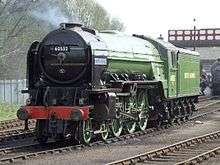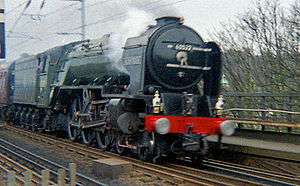LNER Peppercorn Class A2 60532 Blue Peter
|
60532 Blue Peter passes at speed through Durham station | |||||||||||||||||||||||||||||||||||||||||||||||
| |||||||||||||||||||||||||||||||||||||||||||||||
| |||||||||||||||||||||||||||||||||||||||||||||||
| |||||||||||||||||||||||||||||||||||||||||||||||
| |||||||||||||||||||||||||||||||||||||||||||||||
LNER Peppercorn A2 Class No. 60532 Blue Peter is the sole survivor of 15 locomotives of the 4-6-2 Peppercorn A2 Class, designed by Arthur Peppercorn of the LNER. 60532 worked between 1948 and 1966. It is owned by the Royal Scot Locomotive and General Trust (RSL>), currently under overhaul at their LNWR Heritage facility based at Crewe.
Construction
60532 was built at Doncaster Works and out shopped by the newly formed British Railways on 25 March 1948. The initial livery was LNER apple green with British Railways on the tender sides.
60532 was named in the LNER tradition of using the names of famous racehorses. Blue Peter III was the name of a horse owned by Harry Primrose, 6th Earl of Rosebery, which in 1939 won races including the Epsom Derby and the 2000 Guineas. The horse earned almost £32,000 for Lord Rosebury, more than enough to purchase three Doncaster Pacific locomotives at the time.[1]
BR service
Initially all the A2s were allocated to English sheds. 60532 was allocated to the North Eastern Region of BR at York, where it worked principally over the East Coast Main Line.[1]
In the autumn of 1949 five A2's were overhauled at Doncaster where a number of modifications were made, including the fitting of a multiple valve regulator and a double blastpipe and chimney, together with Kylchap cowls. In addition, 60532 received a second whistle placed offside behind the chimney. This chime whistle is being sounded in the illustration above. Subsequently the five A2's, including 60532, moved to Scotland to make up for deficiencies experienced with the Thompson Class A2/2's (rebuilt LNER Class P2). 60532 was allocated to Aberdeen,[1] with all the Scottish-based A2s used mainly on express passenger services between Aberdeen and Edinburgh, which benefited from their greater power and acceleration.[2]
After the English-based A2's were withdrawn in 1962/3, the three remaining Scottish A2's remained in service until 1966.[2] Replaced by diesel power, 60532 was allocated to Dundee and became the last Peppercorn Pacific to be overhauled at Darlington Works. As a result, it was often requested for rail tours, working as far as Holyhead and Exeter St Davids.[1]
60532's final rail tour was in October 1966 over the Waverley Line and the West Coast Main Line over Beattock. 60532 was withdrawn from service on 31 December 1966, and put into store.[1]
Preservation
Geoff Drury had purchased LNER Class A4 4464 Bittern from British Rail in 1966. In 1968, he tried to buy an A1, but after the last one was cut up he was offered and purchased 60532 in 1968.[1]
After preservation, 60532 was the subject of a campaign for its restoration on the BBC Television series Blue Peter, and the locomotive has subsequently featured several times in the programme.[3] Restoration was undertaken at York, Leeds and Doncaster Works where it was repainted in LNER apple green livery as No 532. 60,000 people witnessed its renaming by the BBC Blue Peter programme presenters at a Doncaster Works Open Day in 1971.[1]
Moved to the Dinting Railway Centre, it did little running and in late 1987, the North Eastern Locomotive Preservation Group (NELPG) took charge of 60532 and A4 Bittern on long-term loan from the Drury family.[4] Restored at the Imperial Chemical Industries works at Wilton, Redcar and Cleveland, 60532 was renamed by the BBC Blue Peter programme for a second time in December 1991.
It was then moved to the North Yorkshire Moors Railway for running in. The locomotive obtained its main line certificate in 1992 and subsequently worked many rail tours over the Settle and Carlisle Railway and as far north as its old depot of Aberdeen.[1]
1994 accident
In 1994, during the first run of a preserved steam locomotive from Edinburgh to Newcastle and York, 60532 suffered extensive damage during a catastrophic uncontrolled wheelslip.
During an unscheduled stop at Durham station the inexperienced footplate crew overfilled the boiler. As the train departed south across Durham viaduct an initial slip was poorly controlled by the driver, who then reopened the regulator too early, probably worried about stalling on the bank up to Relly Mill. The force of the initial slip caused the boiler to prime, carrying water over into the regulator valve and jamming it open. This allowed passage of steam through to the cylinders, perpetuating the slip and accelerating the driving wheels. When the driver attempted to wind the reversing gear back into mid-position to halt the slip, the force of the motion spun it into full-forward position, and the driving wheels reached a rotational speed of 140 miles per hour before the cylinder heads blew off and the motion disintegrated.
The driver suffered major injury to his arms, as a result of the screw reversing lever whipping around when he released it. The accident brought to light the importance of train crews being trained on the specific locomotives they were driving, rather than simply a common general instruction on steam locomotives. Neither the driver or fireman had ever worked 60532 before, and were unaware of the locomotive's sensitivity to priming, which led to the accident.
Post 1994

The damage to the motion, cylinders and driving wheels was devastating. The locomotive was moved to Thornaby MPD, where the repair work took 18 months to complete.[1] 60532 was then moved again to the NYMR for running in. The locomotive resumed its mainline career in November 1996, working a charter from Middlesbrough to Preston via Newcastle and Carlisle.[1]
In 1998 60532 ran an Edinburgh to London excursion to mark the 40th anniversary of the Blue Peter TV programme. The trip was Day's Out Limited's "Heart of Midlothian" which had run from Kings Cross to Edinburgh behind a diesel and 60532 worked the journey south with members of the Blue Peter team traveling on board. One presenter Stuart Miles even travelled on the footplate between Newark and Peterborough as that was the section that Mallard set the speed record in 1938.
60532's mainline certificate expired in September 2001 and after that she was then based at the NYMR, where it worked until the end of the 2002 season when her boiler certificate expired.[1] It was subsequently displayed at the Darlington Railway Centre and Museum. On 22 May 2007 BBC Look North News reported that the locomotive was being moved into storage in Chesterfield, due to the renovation of the museum, and would not be returning.
After 60532 was moved to the Barrow Hill Engine Shed in Derbyshire, the NELPG hoped to raise £600,000 for restoration of the locomotive to main line running.[1] There she was repainted to British Railways apple green livery, similar to the first livery used on the A1 Class 60163 Tornado. However, in October 2014 the engine was sold by the Drury family to Jeremy Hosking under the ownership of the RSL>, who plan to restore her to mainline standard with a return scheduled for 2016.[5] The locomotive was moved to the LNWR Heritage facility at Crewe in May 2015 and is currently under overhaul.
References
| Wikimedia Commons has media related to LNER Peppercorn Class A2 60532 Blue Peter. |
- 1 2 3 4 5 6 7 8 9 10 11 12 Hutchinson, Paul. "History of A2 No. 60532 Blue Peter". NELPG. Retrieved 2014-11-14.
- 1 2 "The Peppercorn A2 Pacifics". The London & North Eastern Railway (LNER) Encyclopedia. Retrieved 2014-11-14.
- ↑ Blue Peter (8th book ed.). BBC. 1971. ISBN 0-563-10308-6.
- ↑ "About NELPG". NELPG. 2009-02-15. Retrieved 2014-11-14.
- ↑ "Hosking acquires 532 Blue Peter for RSL>". The Railway Magazine. October 2014.
External links
- 60532 Blue Peter official site at the NELPG
- Video footage of the 1994 slip
- Audio recording from on board 60532 during the 1994 slip
- YouTube clip "Blue Peter NYMR 1991" sounding the second whistle it once had.
